
When the Roman Empire divided into east and west in 395, the territories of modern Albania became a part of the Byzantine Empire. At the end of the 12th century, the Principality of Arbanon was formed which lasted until mid 13th century, after its dissolution it was followed with the creation of the Albanian Kingdom after an alliance between the Albanian noblemen and Angevin dynasty. After a war against the Byzantine empire led the kingdom occasionally decrease in size until the Angevins eventually lost their rule in Albania and led the territory ruled by several different Albanian chieftains until the mid 14th century which for a short period of time were conquered by the short-lived empire of Serbia. After its fall in 1355 several chieftains regained their rule and significantly expanded until the arrival of the Ottomans after the Battle of Savra.
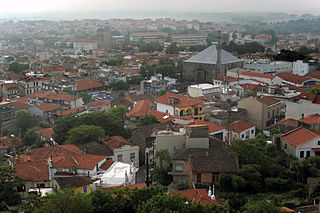
Didymoteicho is a city located on the eastern edge of the Evros regional unit of Eastern Macedonia and Thrace, in northeastern Greece. It is the seat of the municipality of the same name. The town sits on a plain and located south east of Svilengrad, south of Edirne, Turkey and Orestiada, west of Uzunköprü, Turkey, about 20 km north of Soufli and about 90 km north of Alexandroupoli. The municipality of Didymóteicho has a land area of 565.4 km² and a population of 19,493 inhabitants.

Lovech is a city in north-central Bulgaria. It is the administrative centre of the Lovech Province and of the subordinate Lovech Municipality. The city is located about 150 kilometres northeast from the capital city of Sofia. Near Lovech are the towns of Pleven, Troyan and Teteven.

Ivan Shishman ruled as emperor (tsar) of Bulgaria in Tarnovo from 1371 to 3 June 1395. The authority of Ivan Shishman was limited to the central parts of the Bulgarian Empire.

The Second Bulgarian Empire was a medieval Bulgarian state that existed between 1185 and 1396. A successor to the First Bulgarian Empire, it reached the peak of its power under Tsars Kaloyan and Ivan Asen II before gradually being conquered by the Ottomans in the late 14th century.
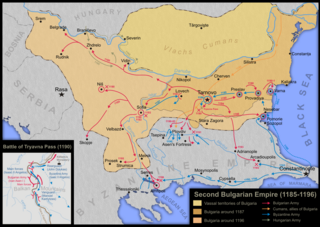
The Uprising of Asen and Peter was a revolt of Bulgarians and Vlachs living in Moesia and the Balkan Mountains, then the theme of Paristrion of the Byzantine Empire, caused by a tax increase. It began on 26 October 1185, the feast day of St. Demetrius of Thessaloniki, and ended with the restoration of Bulgaria with the creation of the Second Bulgarian Empire, ruled by the Asen dynasty.
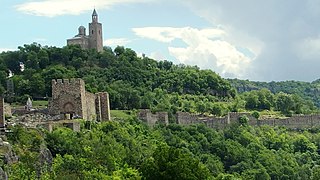
Tsarevets is a medieval stronghold located on a hill with the same name in Veliko Tarnovo in northern Bulgaria. Tsarevets is 206 metres (676 ft) above sea level. It served as the Second Bulgarian Empire's primary fortress and strongest bulwark between 1185 and 1393, housing the royal and the patriarchal palaces, and it is also a popular tourist attraction.

The stronghold of Cherven was one of the Second Bulgarian Empire's primary military, administrative, economic and cultural centres between the 12th and the 14th century. The ruins of the fortress are located near the village of the same name 30 to 35 kilometres south of Rousse, northeastern Bulgaria.
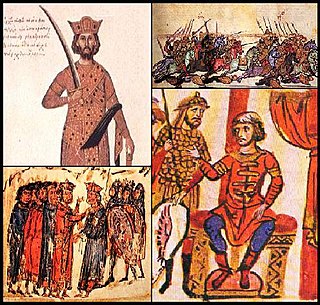
The Byzantine–Bulgarian wars were a series of conflicts fought between the Byzantines and Bulgarians which began when the Bulgars first settled in the Balkan peninsula in the 5th century, and intensified with the expansion of the Bulgarian Empire to the southwest after 680 AD. The Byzantines and Bulgarians continued to clash over the next century with variable success, until the Bulgarians, led by Krum, inflicted a series of crushing defeats on the Byzantines. After Krum died in 814, his son Omurtag negotiated a thirty-year peace treaty. Simeon I had multiple successful campaigns against the Byzantines during his rule from 893 to 927. His son Peter I negotiated another long-lasting peace treaty. His rule was followed by a period of decline of the Bulgarian state.

The Bulgarian–Ottoman wars were fought between the kingdoms remaining from the disintegrating Second Bulgarian Empire, and the Ottoman Empire, in the second half of the 14th century. The wars resulted with the collapse and subordination of the Bulgarian Empire, and effectively came to an end with the Ottoman conquest of Tarnovo in July 1393, although other Bulgarian states held out slightly longer, such as the Tsardom of Vidin until 1396 and the Despotate of Dobruja until 1411. As a result of the wars the Ottoman Empire greatly expanded its territory on the Balkan peninsula, stretching from the Danube to the Aegean Sea.
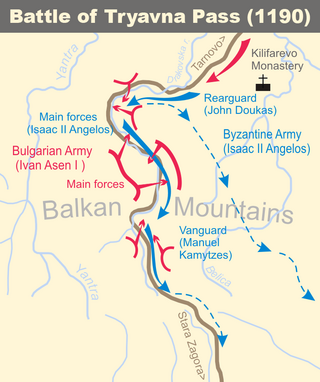
The Battle of Tryavna occurred in 1190, in the mountains around the contemporary town of Tryavna, central Bulgaria. The result was a Bulgarian victory over the Byzantine Empire, which secured the successes achieved since the beginning of the Rebellion of Asen and Peter in 1185.

The Frankokratia, also known as Latinokratia and, for the Venetian domains, Venetokratia or Enetokratia, was the period in Greek history after the Fourth Crusade (1204), when a number of primarily French and Italian states were established by the Partitio terrarum imperii Romaniae on the territory of the dissolved Byzantine Empire.
The territory of modern Albania was part of the Bulgarian Empire during certain periods in the Middle Ages and some parts in what is now eastern Albania were populated and ruled by the Bulgarians for centuries. Most of Albania became part of the First Empire in the early 840s during the reign of Khan Presian. Some coastal towns such as Durrës remained in the hands of the Byzantines for most of that period. The castles of the inner mountainous country remained one of the last Bulgarian strongholds to be conquered by the Byzantines in 1018/1019 during the fall of the First Bulgarian Empire — Tomornitsa. During the Byzantine rule Albania was one of the centres of a Uprising of Peter Delyan. The last Bulgarian Emperor to govern the whole territory was Ivan Asen II (1218–1241) but after his successors the Bulgarian rule diminished. Much of that area corresponded with the Bulgarian historical region Kutmichevitsa.

The Uprising of Ivaylo was a rebellion of the Bulgarian peasantry against the incompetent rule of Emperor Constantine Tikh and the Bulgarian nobility. The revolt was fuelled mainly by the failure of the central authorities to confront the Mongol menace in north-eastern Bulgaria. The Mongols had looted and ravaged the Bulgarian population for decades, especially in the region of Dobrudzha. The weakness of the state institutions was due to the accelerating feudalisation of the Second Bulgarian Empire.

The siege of Lovech took place in the spring of 1187 between the forces of Bulgaria and the Byzantine Empire. The three-month siege resulted in Bulgarian victory and Byzantine defeat.

Ivaylo, also spelled Ivailo, was a rebel leader who ruled briefly as tsar of Bulgaria. In 1277, he spearheaded a peasant uprising and forced the Bulgarian nobility to accept him as emperor. He reigned as emperor from 1278 to 1279, scoring victories against the Byzantines and the Mongols. Beset by foreign and domestic enemies, which included the Bulgarian nobles, he was eventually forced into exile among the Mongols, where he presented himself as a dethroned vassal. The Mongols then killed him in 1281 as an enemy of the Byzantine emperor Michael VIII Palaeologus.
Lardea or Lardeya is a ruined late Roman and medieval fortress, situated near the village of Lozenets in Straldzha Municipality, Yambol Province, south-eastern Bulgaria. In the Middle Ages, Lardea often changed hands between Bulgaria and Byzantium.
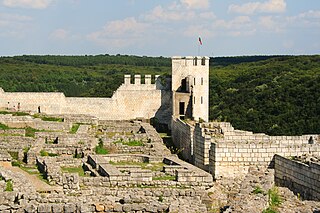
The Shumen fortress is an archaeological site overlooking the city of Shumen in north-eastern Bulgaria.
The Despotate of Lovech, was a Bulgarian state, covering parts of the territory of what is now Lovech Province, formed in 1330 after Ivan Alexander was appointed to govern Lovech, the capital of the despotate, and the nearby area around the town. It was dissolved after the fall of the Lovech Fortress in 1446 to the Ottomans.
















